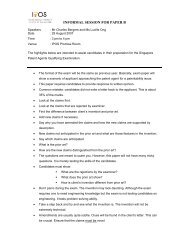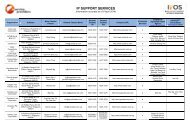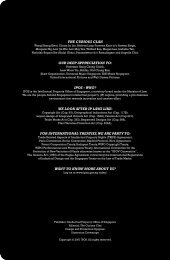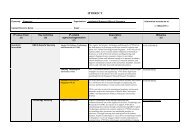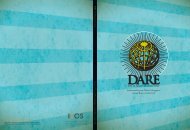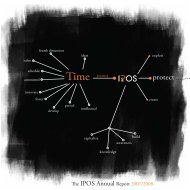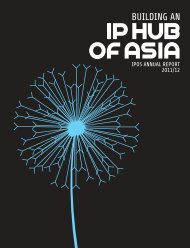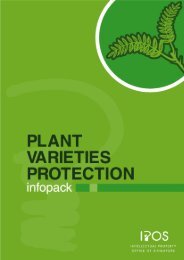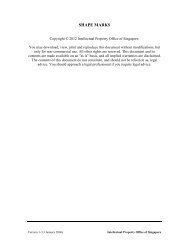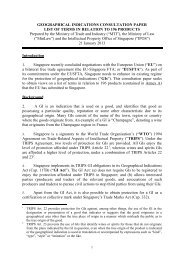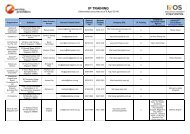Letter & Annex A - Intellectual Property Office of Singapore
Letter & Annex A - Intellectual Property Office of Singapore
Letter & Annex A - Intellectual Property Office of Singapore
Create successful ePaper yourself
Turn your PDF publications into a flip-book with our unique Google optimized e-Paper software.
<strong>Annex</strong> A7 Other Proposed Changes: Second or Subsequent New Medical Use Claims7.1 Background: Section 14(7) <strong>of</strong> the SG Patents Act mirrors section 2(6) <strong>of</strong> the UKPatents Act 1977 before it was amended via the UK Patents Act 2004. In turn, the UKprovision shares its roots with a corresponding article in the European PatentConvention.7.2 As one reads this provision, one will invariably notice that it provides an exception asto what is conventionally known to be the test for novelty. Very simply put, it saysthat in the context <strong>of</strong> a medical use, an invention can be new notwithstanding that theinvention consists <strong>of</strong> a known product if the use <strong>of</strong> that product in the medical usecontext is new.7.3 This leads us to section 16(2) <strong>of</strong> the SG Patents Act (UK & EPC share similar features)which prevents an invention <strong>of</strong> a method <strong>of</strong> treatment <strong>of</strong> the human or animal body bysurgery or therapy or <strong>of</strong> diagnosis practised on the human or animal body, from beingcapable <strong>of</strong> industrial application. This exception to patentability finds support inArticle 27(3)(a) <strong>of</strong> the Agreement on Trade Related Aspects <strong>of</strong> <strong>Intellectual</strong> <strong>Property</strong>Rights (TRIPS) which says that “Members may also exclude from patentability:diagnostic, therapeutic and surgical methods for the treatment <strong>of</strong> humans or animals”.7.4 Current: Hence, what we see in patent legislation in general, is an attempt to balancethe interests <strong>of</strong> both the patent holders as well as the public at large. On one hand,there is a need to encourage medical research with regards to methods <strong>of</strong> medicaltreatment on humans and animals but on the other hand, we should be cautious not tounduly restrain the practice <strong>of</strong> those who perform such medical treatments.7.5 With this balance in mind, case law in UK and Europe prior to the relatively recentamendments have interpreted the SG section 14(7) equivalent to allow for a knownproduct to be patented on the basis <strong>of</strong> its new medical use (i.e. first medical use), eventhough that use is itself unpatentable. In addition, with the emergence <strong>of</strong> second orsubsequent new medical uses, judges started recognizing novelty in them if the patentclaims are drafted in a certain manner (also known as “Swiss-type claims”). Thishowever spurred a proliferation <strong>of</strong> case law and some questioned whether such aninterpretation had the necessary legislative support.7.6 This concern was addressed in one <strong>of</strong> the amending provisions found in the UKPatents Act 2004 and in the Explanatory Notes which was released, the amendment toUK section 2(6) as it was then was explained as follows:19. New section 4A(3) and (4) is concerned with the patentability <strong>of</strong>inventions consisting <strong>of</strong> a known substance or composition for use in a method<strong>of</strong> treatment or diagnosis, and corresponds to Article 54(4) and (5) EPC 2000.While these subsections do not extend the availability <strong>of</strong> patent protection inrespect <strong>of</strong> an invention consisting <strong>of</strong> a substance or composition for use in amethod <strong>of</strong> treatment or diagnosis, they simplify and clarify the manner inwhich patent protection may be obtained for such inventions.Page 29 <strong>of</strong> 31



